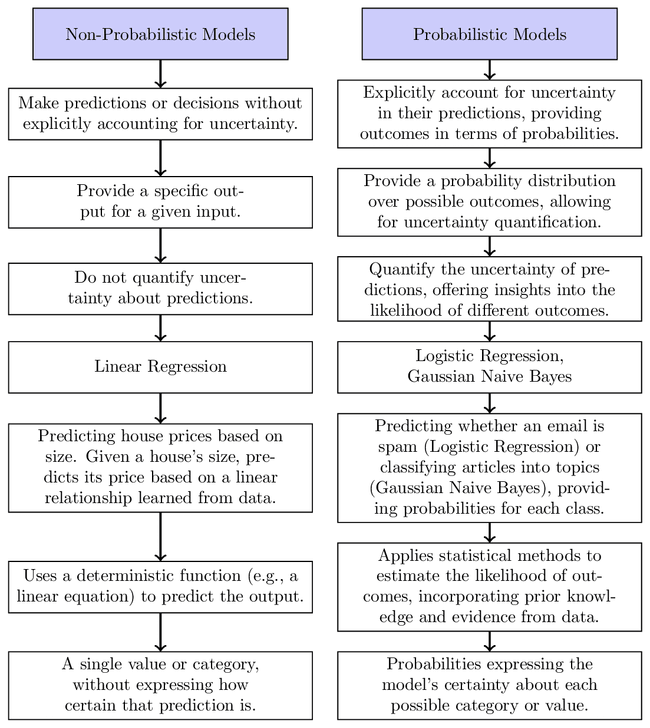non-probabilistic (deterministic) models and probabilistic models
Nonprobabilistic deterministic models and probabilistic models are often categorized into two broad types based on...
%20models%20and%20probabilistic%20models.jpg)
Non-probabilistic (deterministic) models and probabilistic models🔗

Non-probabilistic (deterministic) models and probabilistic models🔗
In the realm of machine learning and statistical modeling, models are often categorized into two broad types based on how they handle uncertainty and make predictions: non-probabilistic (deterministic) models and probabilistic models. Let's explore both types with suitable examples.
Non-Probabilistic (Deterministic) Models🔗
Overview: Non-probabilistic models, or deterministic models, make predictions or decisions without explicitly accounting for uncertainty. For a given input, these models will always produce the same output, without providing probabilities of different outcomes.
Example: Linear Regression (Simple Linear Regression)
- How It Works: Linear regression predicts a dependent variable (y) based on the value of an independent variable (x) by fitting a linear equation to observed data. The equation of a line is , where is the slope, and is the y-intercept.
- Deterministic Nature: For a given , linear regression provides a specific prediction for without quantifying uncertainty about this prediction (though in practice, measures like R-squared and confidence intervals can give some insight into the model's performance and the prediction's reliability).
Example Usage: Predicting house prices based on their size. Given the size of a house, the model predicts its price based on a linear relationship learned from training data.
Probabilistic Models🔗
Overview: Probabilistic models, in contrast, explicitly account for uncertainty in their predictions. They provide outcomes in terms of probabilities, allowing for a more nuanced understanding of the possible outcomes and their likelihoods.
Example: Logistic Regression
- How It Works: Logistic regression estimates the probability that a given input point belongs to a particular category. It models the probability that an observation is in the default class (e.g., "1") as a logistic function of a linear combination of the predictors.
- Probabilistic Nature: For a given set of predictor values, logistic regression provides a probability score between 0 and 1, indicating how likely it is that the observation belongs to the class labeled "1".
Example Usage: Predicting whether an email is spam or not. Given features of an email, logistic regression estimates the probability of it being spam.
Example: Gaussian Naive Bayes
- How It Works: This is a probabilistic classifier that applies Bayes' theorem with a strong (naive) assumption of independence between the features. It assumes that the presence (or absence) of a particular feature in a class is unrelated to the presence (or absence) of any other feature, and it models the distribution of features in each class as a Gaussian (normal) distribution.
- Probabilistic Nature: It calculates the probability of each class given the input features and classifies the input by selecting the class with the highest posterior probability.
Example Usage: Classifying articles into topics. Given the words in an article, Gaussian Naive Bayes can compute the probability of the article belonging to different topics and classify it into the topic with the highest probability.
Summary🔗
The key difference between non-probabilistic and probabilistic models lies in how they handle and represent uncertainty:
- Non-Probabilistic Models: Provide specific outputs for given inputs without quantifying uncertainty about these outputs. They are straightforward and can be easier to interpret but might not always capture the complexity of real-world phenomena where uncertainty is inherent.
- Probabilistic Models: Offer a probabilistic understanding of the relationship between inputs and outputs, providing not just predictions but also the likelihood of those predictions. This allows for a more nuanced decision-making process that can consider the uncertainty of outcomes.
Both model types have their applications and strengths, with the choice depending on the specific requirements of the task, including the need for uncertainty quantification and the nature of the data.
COMING SOON ! ! !
Till Then, you can Subscribe to Us.
Get the latest updates, exclusive content and special offers delivered directly to your mailbox. Subscribe now!